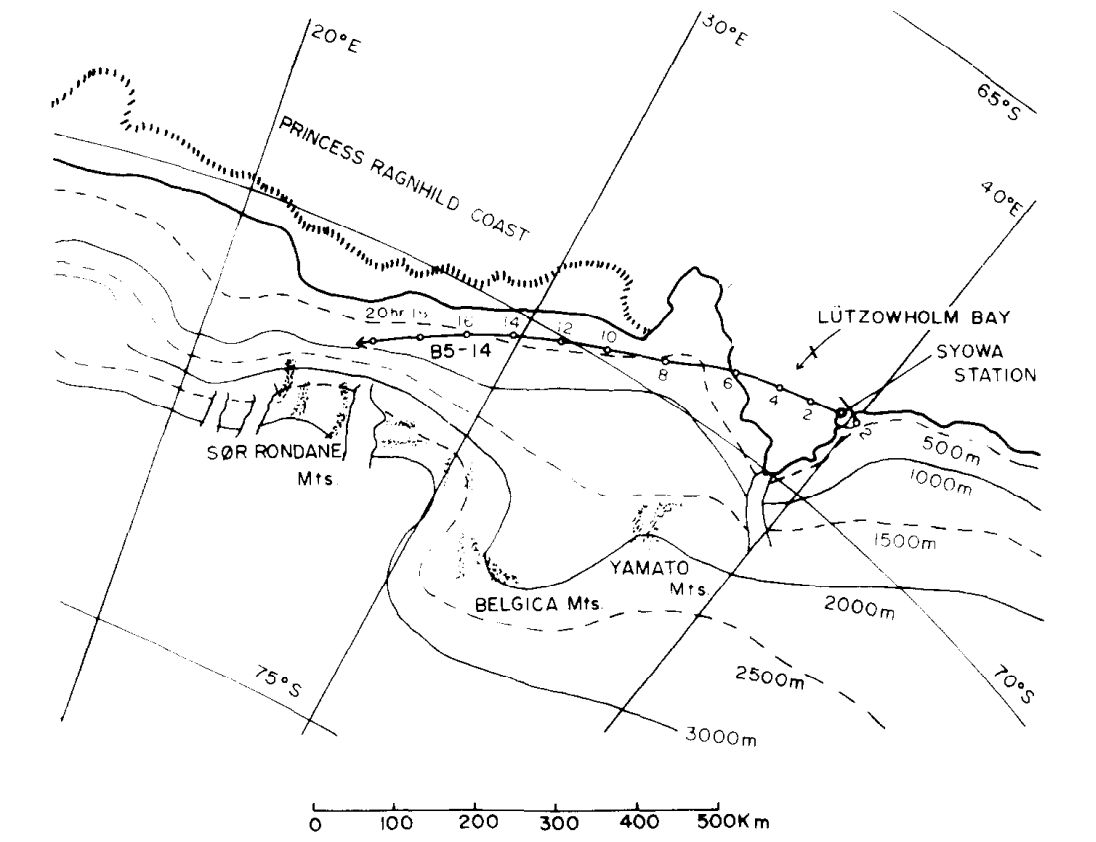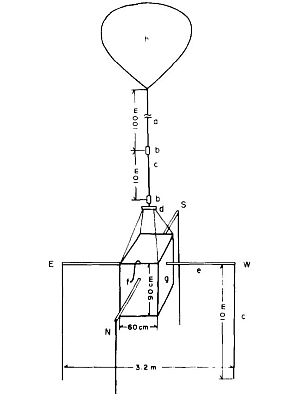Purpose of the flight and payload description
Objective of the flight was to measure the vector electric field and current in the stratosphere in Antarctica. The project was carried out by the Geophysical Institute of the Kyoto University, the Institute of Physical and Chemical Research and with the support of the personnel from the 13th Japanese Antarctic Research Expedition,
The payload can be seen schematicaly in the image at left (click to enlarge). It was composed of five antenna elements and a telemetering system at 1680 MHz. The physical instruments were suspended with a 100 meter-long nylon cord (a) below a 5.000 m3 stratospheric balloon (h). Horizontal antennas consisted of two pairs of steel wires 2 mm in diameter and 10 meters long. The upper antenna was made of the same kind of wire and was insulated from the nylon cord using teflon (b). Electric fields were obtained by measuring the potential difference between the upper antenna and the horizontal ones antennas, N, for the vertical component and those between the antennas of N-S and E-W for the horizontal components.
The effective antenna separations were 10 m for the vertical and 3.2 m for the horizontal antennas. The effective antenna areas for the current measurements were 36.3 m2 for the vertical and 12.4 m2 for the horizontal antennas. Many other additional physical instruments were carried by the balloon: a fluxgate-type magnetometer, a level meter for the horizontal antennas, an aneroid barometer, a thermister thermometer, a modulator and the transmitter.
Details of the balloon flight

Balloon launched on: 12/29/1972 at 14:37 UTC
Launch site: Syowa Station, Antarctica
Balloon launched by: NIPR / ISAS
Balloon manufacturer/size/composition: Zero Pressure Balloon model B5 5.000 m3
Flight identification number: B5-14
End of flight (L for landing time, W for last contact, otherwise termination time): 12/30/1972
Balloon flight duration (F: time at float only, otherwise total flight time in d:days / h:hours or m:minutes - ): 24 h
The balloon was launched from the Syowa Station in Antarctica at 14:37 UTC on 29 December 1972 as flight number B5-14. The balloon ascended at a speed of 250-260 m/min up to a ceiling altitude of 31 km. During level floating the balloon drifted to WNW over Lutzowholm Bay to the Sor Rondane Mountaines at a mean speed of 8.7 m/s. However, it sank gradually after arrival at the ceiling altitude. Total flight time was 24 hours.
External references
- Future Plans of Stratospheric Balloon Observation ELS Departmental Bulletin Paper, 1979-03, P. 113
- Stratospheric electric fields and currents measured at Syowa Station, Antarctica - 1. The vertical component Journal of Atmospheric and Terrestrial Physics, Volume 39, Issue 4, 1977, Pag. 523
14743If you consider this website interesting or useful, you can help me to keep it up and running with a small donation to cover the operational costs. Just the equivalent of the price of a cup of coffee helps a lot.


